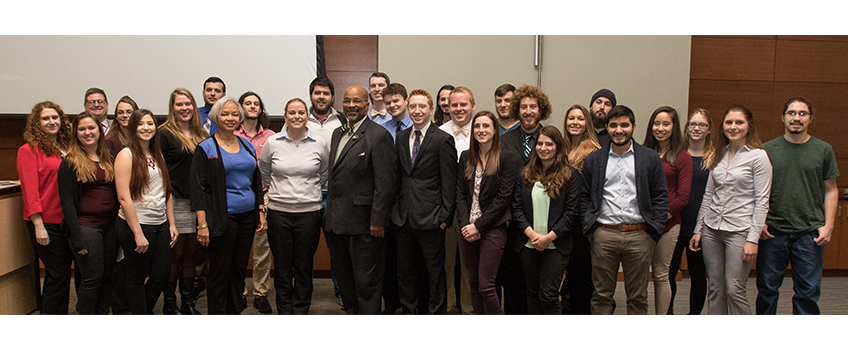Stockton Students Find Hope for Bridgeton’s Sunset Lake After Semester of Resource Assessment

For Immediate Release; Photos on Flickr
Contact: Susan Allen
News and Media Relations
Galloway, N.J. 08205
Susan.Allen@stockton.edu
(609) 652-4790
www.stockton.edu/media
Galloway, N.J. - Bridgeton City Park served as a community classroom for Stockton University students studying environmental issues with Emma Witt, assistant professor of Environmental Science. After a semester-long resource assessment of the Cohansey watershed and Sunset Lake, the class presented their findings and recommendations to Bridgeton Mayor Albert Kelly and city officials.
Months of data collection has provided a solid baseline and hope for the lake, which is closed to swimmers due to bacteria. The students called for continued monitoring to collect a more complete data set, which is necessary to take the next steps in creating a healthier, more diverse ecosystem.
The Cohansey watershed and Sunset Lake have a history of support for the agriculture, iron and timber industries. The waterways connect Bridgeton to the Delaware Bay and offer an escape into nature within an urban environment.
On the bicentennial of the Sunset Lake raceway (hand-dug in 1811 for timber transport), severe storms caused significant damage resulting in a drained lake. With help from the Federal Emergency Management Agency (FEMA), water re-entered the raceway in 2015, but high bacteria levels have since ended swimming in the lake.
Students gained experience in testing water samples for total coliforms, nitrate and total phosphorus, building on work shared by the Cumberland County Health Department and Rutgers Cooperative Extension. The students recommended more comprehensive and long-term testing to add to existing data and gain a clearer picture of the situation.
Other teams of students looked at macroinvertebrates, which are indicators of water quality, and found the highest populations were species that are the most tolerant of pollution. Fish, reptiles, amphibians, raptors and waterfowl, including a large population of resident geese, were also studied through seine netting and observation, sometimes by kayak for the waterfowl that live past the shoreline.
Thomas Johnson, a senior Environmental Science major from Tabernacle, Burlington County, flew a drone to access the more remote areas in search of suitable habitat.
Kimberly Dudek, a senior Environmental Science major from Pine Beach, Ocean County, explained that her work focused on answering the question: “What can we do to improve the health of the forest and increase biodiversity?”
Her team gained hands-on experience developing a forest management plan tailored to the park environment. They found a healthy oak-dominated forest that could benefit from some clear cuts and thinning of trees to open up space that would attract species that prefer a young forest habitat. Controlled burning is a management technique they would avoid, based on the proximity to residents in the city.
Other recommendations included more detailed signage to educate the community about the biodiversity, a nine-hole disc golf course to increase visitation, installation of birdhouses and bat houses by volunteers, seeking Green Acres grant funding for future projects and additional pedestrian signage for safety in areas where trails cut across roadways.
Mayor Albert Kelly said, “This partnership is made in heaven. It gives us great information about the resources we have in our city and Stockton went far and above what I had expected. The students gave us a plan that reinforces some things we need to do in our entire recreational park area. Having students at Stockton was fantastic for us. I look forward to a greater and even more in-depth relationship with Stockton because they can do things for us that we cannot do for ourselves.”
Blake Maloney, president of the Cohansey Area Watershed Association (CAWA) and a resident who lives on the lake, was very excited to learn about the students’ efforts.
CAWA, which meets once a month, conducts water sampling and cleanups and involves area schools and volunteers in helping to protect the natural areas. As someone who fishes, kayaks and canoes on the lake, Maloney said, “I love it. The lake has always been there for everybody.”
Dawn Watkins, who grew up in Bridgeton and has worked on a number of Science, Technology, Engineering and Mathematics (STEM) initiatives, connected Stockton, where she works in the School of Social and Behavioral Sciences, with her hometown. She knew that the lake contamination had to be addressed and saw an opportunity for students to “put their skills to work in a real-world setting” which would benefit the city and provide them with an experience that could make a difference.


